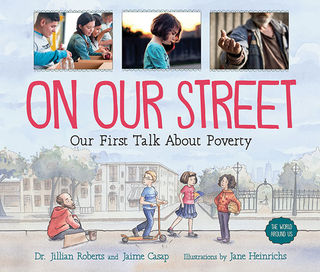Child Development
World Poverty Day: Conversation Starters to Use with Kids
Research can inform how we engage in conversations about poverty with children.
Posted October 16, 2019 Reviewed by Lybi Ma
NOTE: This post was co-authored with members of the CUESI Lab—Lindsey Nenadal, Ph.D., Katherine Griffin, Ph.D., Taylor Hazelbaker, M.A., and Kristina Brittenham, J.D.

A few years back, while driving around Los Angeles, my then 4-year-old son asked me to read a sign held by a panhandler on a street corner. His immediate response upon hearing what it said— “Can we give him some money to help?”—meant that for some time thereafter, we regularly kept extra dollar bills in the car.
As parents, we are told to read with our children daily and expose them to a variety of print materials. We don’t typically think of a panhandler’s sign as print exposure—yet panhandlers and homeless encampments are two very visible signs of poverty that children growing up in Los Angeles (and other major cities) encounter daily. For many, it remains the most visible and salient dimension of poverty. Homelessness in LA and elsewhere is plain to see, even for the youngest child.
As adults, we might debate the merits of giving money to panhandlers. As a parent and scholar who studies the consequences of poverty on family life and children’s development, I saw this moment as an opportunity to begin conversations about poverty, homelessness, and inequality with my own child. Age 4, as it turns out, is a great time to start having such conversations—and regardless of your own child's age, there is no time better than October to do so.
October 17, 2019 is the United Nations-designated "International Day for the Eradication of Poverty," and the UN has named elimination of poverty by 2030 as one of its 17 Sustainable Development Goals. The numbers are sobering: 10 percent of the world's population (700 million people) live in conditions of extreme poverty, surviving on less than US $1.90 per day. Children are among those at greatest risk for experiencing poverty, both internationally and in the United States. Here, nearly one in five children grow up poor, and economic inequality—the gap between the richest and poorest individuals in a society—is higher than it has been in over 50 years.
The theme of this year’s International Day for the Eradication of Poverty, “Acting together to empower children, their families and communities to end poverty,” reminds us that while addressing poverty and inequality is a societal and structural issue, how we respond, engage, and act with children, families, and adults in our own communities makes a difference. And research suggests that children are ready and willing to participate.
Adults often assume that children are too young to recognize or understand economic differences in society—yet robust research evidence suggests that children are far from "economically blind." By the time children enter preschool, studies have shown that they are aware of differences between the rich and the poor. By the end of elementary school, their beliefs about wealth and poverty approximate adults' stereotypic beliefs—including that the poor are to blame for their plight.
Children are also more likely to endorse negative traits about low-income peers and to exclude them as compared with wealthy peers. By middle and high school, youth are aware of their own and others' social class position and the status accorded to it. And for those transitioning to college, youth from wealthier backgrounds are more likely to believe they rightfully earned their college admission based on merit, while those from low-income and working class backgrounds struggle with "imposter syndrome" and to fit in socially.
These types of class-based perceptions and experiences, rooted in childhood, have implications for children’s sense of self and future orientations, their beliefs and attitudes about those living in poverty, and about individual and collective responsibility to help those in need. The question appears to be not whether children are aware of poverty, but rather, what can we do to support their understanding in developmentally appropriate and engaging ways?
Our own research at UCLA suggests that engaging with children in conversations about meaningful similarities and differences between wealth and poverty is an important step to reducing stereotypic beliefs and nurturing a sense of critical consciousness and civic identity. Children view poverty and inequality as unfair, and when given the opportunity, they seek to correct disparities.
However, parents and educators often feel unprepared or uncomfortable engaging in conversations about social class with children. Fortunately, there are several excellent strategies to help them get started.
Conversation starters:
- Don’t ignore class, but mind your words. Don’t ignore or “shush” your child’s observations. Use their curiosity to start a conversation. Ask probing questions to assess their understanding—and misunderstanding. Instead of saying “a homeless/poor person,” use phrases like “a person who is homeless” and “people living in poverty.” This reinforces that poverty and homelessness do not define a person, but describe their current circumstances. Use terms such as “none, some, most, all” (e.g., “some people who live in poverty don’t have a home and some people in poverty do”) to combat group stereotypes and reinforce within group heterogeneity.
- Encourage concern, compassion, and action instead of pity. Empathy and perspective-taking skills are hallmarks of childhood. Harness these skills to help children connect, understand, and relate to the experiences of a child or family struggling economically, even if their own family is economically secure.
- Talk about poverty and homelessness as situational, not individualistic. Adults and children often attribute poverty to individual characteristics (e.g., not working hard, not trying, or not spending money wisely). Discuss structural dimensions of poverty, such as low-wages, housing costs, and discrimination with your child.
Ways to engage in your local community:
Communities typically have organizations to help individuals and families in need that often allow families to volunteer or donate goods. Talk to children before and after engaging in this activity. Use some of the tips shared above (or the resources shared below), and encourage your child to ask questions.
Brainstorm ideas for other ways that they (and others) can help, and talk about different types of structural support (e.g., government benefits) that people may receive. Plan to volunteer regularly, as regular contact and exposure are important for reducing stigma and breaking down stereotypes.

Children’s books:
- Last Stop on Market Street, by Matt de la Pena
- Uncle Willie and the Soup Kitchen, by DyAnne Disalvo-Ryan
- A Chair for My Mother, by Vera B. Williams
- The Hundred Dresses, by Eleanor Estes
- Tight Times, by Barbara Shook Hazen
- Those Shoes, by Maribeth Boelts
- Maddie’s Fridge, by Lois Brandt
- Each Kindness, by Jacqueline Woodson
- On Our Street (Our First Talk About Poverty), by Dr. Jillian Roberts & Jaime Casap (non-fiction)
Author Bios: Lindsey’s research addresses teachers and focuses on the development and implementation of social justice curriculum for elementary school students and teachers’ social class beliefs. She is an Assistant Professor of Child Development at California State University, Chico. Katherine is a recent graduate of UCLA and her current research involves a community-based partnership with a local non-profit to address the role of stigmatization in families’ experiences of benefit receipt from non-profit and government organizations. Taylor and Kristina are graduate students in the Human Development & Psychology program in the Department of Education at UCLA.
References
Additional resources to facilitate conversations:
9 ways to do better than Disney at teaching your kids about poverty
14 Ways to Effectively Explain Homelessness and Poverty to Your Child
Teaching Tolerance: Issues of Poverty Lessons
Talking with Children About Poverty and Homelessness
Teacher’s Guide to Literature Around Poverty
Sesame Street addresses homelessness and hunger




